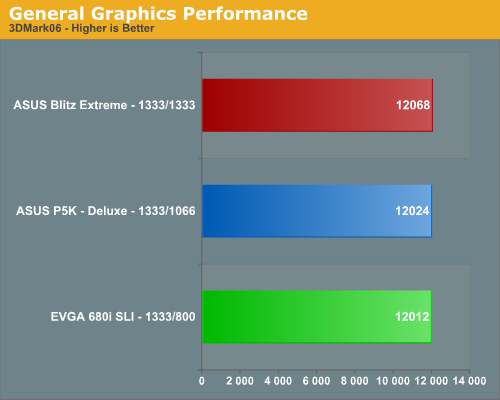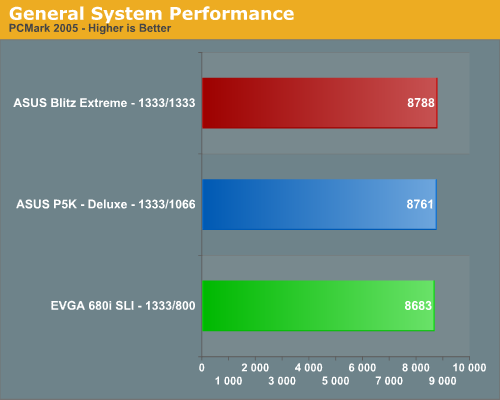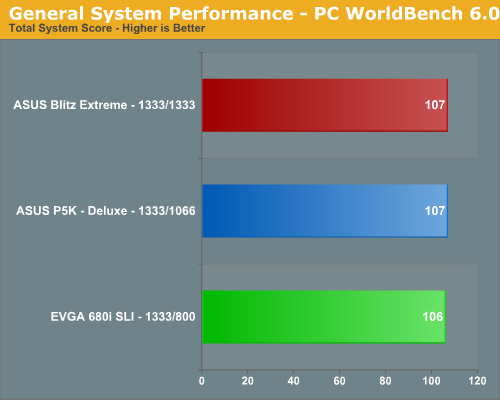NVIDIA 680i SLI: Official 1333MHz FSB CPU Support Arrives
by Gary Key on July 20, 2007 12:01 AM EST- Posted in
- CPUs
Synthetic Graphics Performance:
The 3DMark series of benchmarks developed and provided by Futuremark are among the most widely used tools for benchmark reporting and comparisons. Although the benchmarks are very useful for providing apples-to-apples comparisons across a broad array of GPU and CPU configurations they are not a substitute for actual application and gaming benchmarks. In this sense we consider the 3DMark benchmarks to be purely synthetic in nature but still very valuable for providing consistent measurements of performance.


In our 3DMark06 test, all of the boards are bunched together with a 0.004% spread from top to bottom. In essence all of the boards perform equally from a total score viewpoint. The Intel boards had a 1.8% advantage in the CPU tests while the NV board had a 1.67% advantage in the Graphics section of the test. This will be a familiar pattern in our limited benchmark results today.
In the more memory/CPU throughput sensitive 3DMark01 benchmark we see our Intel boards taking top honors. The spread is only 2.6%, however, so minor differences in performance are not really noticeable in either 3DMark unless you count on the differences for benchmark scores.
General System Performance
The PCMark05 benchmark developed and provided by Futuremark was designed for determining overall system performance for the typical home computing user. This tool provides both system and component level benchmarking results utilizing subsets of real world applications or programs. This benchmark is useful for providing comparative results across a broad array of Graphics, CPU, Hard Disk, and Memory configurations along with multithreading results. In this sense we consider the PCMark benchmark to be both synthetic and real world in nature, and it again provides for consistency in our benchmark results.

The ASUS boards have always done well in this benchmark due to very strong multitasking performance and the same holds true once again with our EVGA board trailing by only 1%. In the individual tests that make up this benchmark, the Intel chipsets scored the best in the CPU and memory sections while the NVIDIA based board had top honors in the graphics and hard disk tests.
The PC WorldBench 6.0 test suite developed and provided by PCWorld is designed for determining overall system performance for the home office user. This tool provides results for 10 different real world applications that range from Adobe Photoshop to AutoDesk 3ds Max. This benchmark is useful for providing comparative results across a broad array of Graphics, CPU, Hard Disk, and Memory configurations.

Once again, we see the Intel P35 chipsets scoring just slightly better than the NVIDIA 680i although the difference is absolutely minimal. Within the individual test scores the same pattern holds true with the Intel chipsets taking top honors in the CPU intensive benchmarks and NVIDIA placing first in the graphic and storage system intensive applications. In fact, if it were not for the 15% lower score in the Nero Recode test, we believe the EVGA board would have had the top overall score.
The 3DMark series of benchmarks developed and provided by Futuremark are among the most widely used tools for benchmark reporting and comparisons. Although the benchmarks are very useful for providing apples-to-apples comparisons across a broad array of GPU and CPU configurations they are not a substitute for actual application and gaming benchmarks. In this sense we consider the 3DMark benchmarks to be purely synthetic in nature but still very valuable for providing consistent measurements of performance.


In our 3DMark06 test, all of the boards are bunched together with a 0.004% spread from top to bottom. In essence all of the boards perform equally from a total score viewpoint. The Intel boards had a 1.8% advantage in the CPU tests while the NV board had a 1.67% advantage in the Graphics section of the test. This will be a familiar pattern in our limited benchmark results today.
In the more memory/CPU throughput sensitive 3DMark01 benchmark we see our Intel boards taking top honors. The spread is only 2.6%, however, so minor differences in performance are not really noticeable in either 3DMark unless you count on the differences for benchmark scores.
General System Performance
The PCMark05 benchmark developed and provided by Futuremark was designed for determining overall system performance for the typical home computing user. This tool provides both system and component level benchmarking results utilizing subsets of real world applications or programs. This benchmark is useful for providing comparative results across a broad array of Graphics, CPU, Hard Disk, and Memory configurations along with multithreading results. In this sense we consider the PCMark benchmark to be both synthetic and real world in nature, and it again provides for consistency in our benchmark results.

The ASUS boards have always done well in this benchmark due to very strong multitasking performance and the same holds true once again with our EVGA board trailing by only 1%. In the individual tests that make up this benchmark, the Intel chipsets scored the best in the CPU and memory sections while the NVIDIA based board had top honors in the graphics and hard disk tests.
The PC WorldBench 6.0 test suite developed and provided by PCWorld is designed for determining overall system performance for the home office user. This tool provides results for 10 different real world applications that range from Adobe Photoshop to AutoDesk 3ds Max. This benchmark is useful for providing comparative results across a broad array of Graphics, CPU, Hard Disk, and Memory configurations.

Once again, we see the Intel P35 chipsets scoring just slightly better than the NVIDIA 680i although the difference is absolutely minimal. Within the individual test scores the same pattern holds true with the Intel chipsets taking top honors in the CPU intensive benchmarks and NVIDIA placing first in the graphic and storage system intensive applications. In fact, if it were not for the 15% lower score in the Nero Recode test, we believe the EVGA board would have had the top overall score.










18 Comments
View All Comments
TA152H - Saturday, July 21, 2007 - link
I see this Asus Blitzkrieg Extreme, but what it is? It kind of gets thrown in there with no explanation, but I can't find anything that describes it, or any mention of it on Asus's website.Don't you think you should have at least mentioned what this thing is? I mean, I gathered it's a P35 DDR3 motherboard, but then so is the P5K3. So, obviously something is different, but no explanation is given.
Chunga29 - Sunday, July 22, 2007 - link
What's an ASUS Commando? Originally it was a P5B Deluxe plus $150. I would guess the Blitzkrieg is about the same: tuned for a bit higher OCing, but really just a more expensive mobo that isn't necessary for 99% of users.Review forthcoming, I'd assume, Gary?
TA152H - Saturday, July 21, 2007 - link
Show me someone with a Nvidia chipset for Intel processors, and I'll show you an idiot. Why would anyone in their right mind even consider a non-Intel chipset, except for real low power uses (which even Intel does for some of their motherboards, from SIS). Intel easily makes the best chipsets and more importantly they are the standard and almost as importantly are extremely well supported by the parent company.Nvidia is fine for a minor company like AMD that can't make a decent chipset, or hasn't chosen to, but for Intel that makes a much broader line of products, which are not only excellent but extremely well supported, Nvidia makes no sense at all. It's not only that, they don't manufacture their products, and now that Intel is moving their chipsets to more modern manufacturing processes, it's obvious they are taking them very seriously.
It's a good review though, just so everyone can see there is no point in Nvidia. Otherwise, there would be those lingering doubts.
ATWindsor - Saturday, July 21, 2007 - link
Theese are extremly seriuos problems with a motherboard, why not focus abit more on functionality and stability and less on overclocking in the reviews, so the users won't get theese nasty suprises?AtW
rjm55 - Friday, July 20, 2007 - link
nVidia can crow all they want about 1333 support, but the fact is their dhipsets don't support DDR3. With the new DDR3-1600, DDR3-1666, and DDR3-2000 low latency parts that have started shipping, nVidia has nothing to crow about. DDR2 has just become obsolete with these new DDR3 parts and nVidia can only handle DDR2. Guess these expensive boards will soon be on closeout at Newegg.TA152H - Saturday, July 21, 2007 - link
I agree, but they probably needed to do nothing to this part, just say it runs at 1333 MHz and thus is compatible with the newer products.Clearly they need a DDR3 chipset, but then again, what is the point of Nvidia chipsets for Intel processors anyway? It's not like Intel's aren't fantastic, or that they overprice them. I don't see any value-add to Nvidia in this space, they take too much power and offer essentially nothing. But, if they insist on staying, they need to get DDR3 out and fast. DDR2 is obsolete, and their chipsets thus are as well.
DigitalFreak - Friday, July 20, 2007 - link
ROFLMAO! You have become obsolete.Here's your sign.
Owls - Friday, July 20, 2007 - link
We lined up several 600i motherboards on the test bench, popped our QX6850 in each one, flipped the switch, and then took several deep breaths as board after board failed to run properly. A couple of boards would not even POST, a few worked fine, and some would boot into Vista and then act strange - not Britney Spears strange mind you; more like Paris Hilton behind bars. You just knew that QX6850 wanted to escape its confines and party all night long, but instead it was limited to a few whimpers and constant pleas for help from its socket induced hell.Get to the point. You don't get +1s for being funny in a professional article, what a joke.
gigahertz20 - Friday, July 20, 2007 - link
Go somewhere else then if you don't like a little humor in the articles. I thought it was funny and plus it's not like we pay to read Anandtech articles, so stop bitching about something you get for free.JKing76 - Friday, July 20, 2007 - link
I notice that this is not a micro-ATX roundup. I notice that a week has elapsed from the specific day we were told the roundup would start. And of course, everyone in the uATX Results thread has noticed that we've been jerked around for three months about this supposed review.